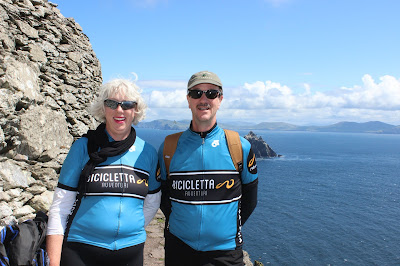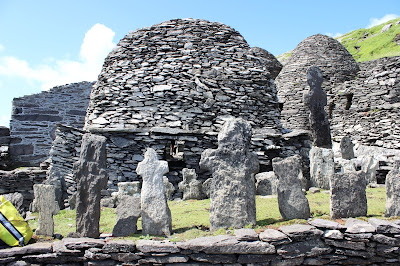Today was an amazing day! Our guide, Wilma had us set up to ride our bikes to the McGee Port, jump on a fishing boat, and tour the Skellig Island.
It was our first day to take a wrong turn on our 12 mile ride and end up at the wrong port. I believe I mentioned the craziness of following maps and reading road signs here. First of all, everything in measured in kilometers which means doing MATH while riding. HA! Needless to say, here we are below, poor souls, lost, dazed and confused. Wilma came and picked us up and drove us to the correct port so we could make our trip!
The earliest reference in history to the Skellig Islands dates back to 600AD. During the time of the Penal Laws, Skellig Michael and Little Skellig became a haven for many Catholics whose beliefs and rights were being suppressed. The largest of the Skelligs is Skellig Michael (Sceilg Mhichil) and was home to one of the earliest monastic settlements in Ireland. The monks of St. Fionan’s monastery led simple lives and lived in stone, beehive shaped huts. They would descend the 670 steps early every morning and fish for the morning’s breakfast and would spend the rest of the day praying in the church, tending to their gardens and studying. The huts, which are round on the outside and rectangular on the inside, were carefully built so that no drop of rain ever entered between the stones. The monks left the island in the thirteenth century and it became a place of pilgrimage. There is a fantastic wealth of birdlife on and around the Skelligs, especially puffins in late spring and gannets on the Small Skellig. The monks of St. Fionan’s monastery led simple lives and lived in stone, beehive shaped huts. They would descend the 670 steps early every morning and fish for the morning’s breakfast and would spend the rest of the day praying in the church, tending to their gardens and studying. The huts, which are round on the outside and rectangular on the inside, were carefully built so that no drop of rain ever entered between the stones. The monks left the island in the thirteenth century and it became a place of pilgrimage. There is a fantastic wealth of birdlife on and around the Skelligs, especially puffins in late spring and gannets on the Small Skellig.
It's incredibly humbling to consider the unspeakable devotion and commitment of these monks who led a "set apart" life commitment to praying, not only to themselves, put to the unreached. Our guide told us this prayer rock was at the edge of the then known world. They dedicated their whole existence to a life as a prayer warrior for God.
Little Skellig is an island in the Atlantic Ocean, 11 km south-west of Valentia Island in County Kerry, Ireland. Little Skellig is the smaller of the two Skellig Islands, the other being Skellig Michael, 1 km to the south-west. The island has a large bird population, including a colony of Northern Gannets which is the largest in Ireland, and one of the largest in the world. The island, together with Skellig Michael, is the center of a 364 ha Important Bird Area established by BirdWatch Ireland in 2000.
We had a wonderful team dinner tonight at our hotel. Such a great group! Really enjoying getting to know my Parker's Team friends
Good night! Tomorrow we ride to Killarney!



























































I know it was not funny getting lost at the time but that story made me laugh because I am terrible at directions & horrific at math. I would have been no help to your team whatsoever! Plus it looks a bit "nippy" (Clark Griswold" along the way! How out of breath was everyone after they climbed those stairs to the top?? And how good were those beers after your long rides & hot showers? Looks like you are having a blast & can't wait to see & hear more!
ReplyDeleteThere were over 600 steps!! I can attest to that because I can barely walk! My thighs hurt so bad.....they have NEVER been this sore!!!! Thankfully, yes to hot showers and warm soup wherever you go....and of course a pint of Guinness at every corner!
ReplyDelete